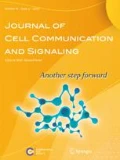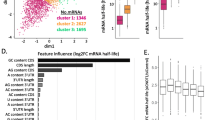Abstract
The 3′-untranslated region (UTR) is known to be a critical regulator of post-transcriptional events that determine the gene expression at the RNA level. The gene CCN1 is one of the classical members of the matricellular CCN family and is involved in a number of biological processes during mammalian development. In the present study, the 600-bp 3′-UTR of CCN1 was functionally characterized. Reporter gene analysis revealed that the entire 3′-UTR profoundly repressed gene expression in cis in different types of the cells, to which both the proximal and distal-halves of the 3′-UTR segments contributed almost equally. Deletion analysis of the 3′-UTR indicated a distinct functional element in the proximal half, whereas a putative target for microRNA-181s was predicted in silico in the distal half. Of note, the repressive RNA element in the proximal half was shown to be capable of forming a stable secondary structure. However, unexpectedly, a reporter construct with a tandem repeat of the predicted miR-181 targets failed to respond to miR-181a. In addition, the other major structured element predicted in the distal half was similarly characterized. To our surprise, the second element rather enhanced the reporter gene expression in cis. These results indicate the involvement of multiple regulatory elements in the CCN1 3′-UTR and suggest the complexity of the miRNA action as well as the 3′-UTR-mediated gene regulation.







Similar content being viewed by others
References
Andreassi S, Riccio A (2009) To localize or not to localize: mRNA fate is in 3'UTR ends. Trends Cell Biol 19:465–474
Bai T, Chen CC, Lau LF (2010) Matricellular protein CCN1 activates a proinflammatory genetic program in murine macrophages. J Immunol 184:3223–3232
Didiano D, Hobert O (2008) Molecular architecture of a miRNA-regulated 3' UTR. RNA 14:1297–1316
Holbourn KP, Acharya KR, Perbal B (2008) The CCN family of proteins: structure-function relationships. Trends Biochem Sci 33:461–473
Holloway SE, Beck AW, Girard L, Jaber MR, Barnett CC Jr, Brekken RA, Fleming JB (2005) Increased expression of Cyr61 (CCN1) identified in peritoneal metastases from human pancreatic cancer. J Am Coll Surg 200:371–377
Ishimaru D, Zuraw L, Ramalingam S, Sengupta TK, Bandyopadhyay S, Reuben A, Fernandes DJ, Spicer EK (2010) Mechanism of regulation of bcl-2 mRNA by nucleolin and A + U-rich element-binding factor 1 (AUF1). J Biol Chem 285:27182–27191
Jacobsen A, Wen J, Marks DS, Krogh A (2010) Signatures of RNA binding proteins globally coupled to effective microRNA target sites. Genome Res 20:1–10
Jun J, Lau LF (2010) The matricellular protein CCN1 induces fibroblast senescence and restricts fibrosis in cutaneous wound healing. Nat Cell Biol 12:676–685
Jun JI, Lau LF (2011) Taking aim at the extracellular matrix: CCN proteins as emerging therapeutic targets. Nat Rev Drug Discov 10:945–963
Kondo S, Kubota S, Eguchi T, Hattori T, Nakanishi T, Sugahara T, Takigawa M (2000) Characterization of a mouse ctgf 3'-UTR segment that mediates repressive regulation of gene expression. Biochem Biophys Res Commun 11:119–124
Kubota S, Kondo S, Eguchi T, Hattori T, Nakanishi T, Pomerantz RJ, Takigawa M (2000) Identification of an RNA element that confers post-transcriptional repression of connective tissue growth factor/hypertrophic chondrocyte specific 24 (ctgf/hcs24) gene: similarities to retroviral RNA-protein interactions. Oncogene 19:4773–4786
Kubota S, Takigawa M (2007a) Role of CCN2/CTGF/Hcs24 in bone growth. Int Rev Cytol 147:1–41
Kubota S, Takigawa M (2007b) CCN family proteins and angiogenesis: from embryo to adulthood. Angiogenesis 10:1–11
Kubota S, Takigawa M (2011) The role of CCN2 in cartilage and bone development. J Cell Commun Signal 5:209–217
Leask A (2010) A sticky situation: CCN1 promotes both proliferation and apoptosis of cancer cells. J Cell Commun Signal 4:71–72
Lee DY, Shatseva T, Jeyapalan Z, Du WW, Deng Z, Yang BB (2009) A 3'-untranslated region (3'UTR) induces organ adhesion by regulating miR-199a* functions. PLoS One 4:e4527
Lin EA, Kong L, Bai XH, Luan Y, Liu CJ (2009) miR-199a, a bone morphogenic protein 2-responsive MicroRNA, regulates chondrogenesis via direct targeting to Smad1. J Biol Chem 284:11326–11335
Mo FE, Muntean AG, Chen CC, Stolz DB, Watkins SC, Lau LF (2002) CYR61 (CCN1) is essential for placental development and vascular integrity. Mol Cell Biol 22:8709–8720
Moritani NH, Kubota S, Sugahara T, Takigawa M (2005) Comparable response of ccn1 with ccn2 genes upon arthritis: An in vitro evaluation with a human chondrocytic cell line stimulated by a set of cytokines. Cell Commun Signal 3:6
Merritt C, Rasoloson D, Ko D, Seydoux G (2008) 3' UTRs are the primary regulators of gene expression in the C. elegans germline. Curr Biol 18:1476–1482
Mukudai Y, Kubota S, Eguchi T, Kondo S, Nakao K, Takigawa M (2005) Regulation of chicken ccn2 gene by interaction between RNA cis-element and putative trans-factor during differentiation of chondrocytes. J Biol Chem 280:3136–3177
Mukudai Y, Kubota S, Kawaki H, Kondo S, Eguchi T, Sumiyoshi K, Ohgawara T, Shimo T, Takigawa M (2008) Posttranscriptional regulation of chicken ccn2 gene expression by nucleophosmin/B23 during chondrocyte differentiation. Mol Cell Biol 28:6134–6147
Murayama A, Weng L, Date T, Akazawa D, Tian X, Suzuki T, Kato T, Tanaka Y, Mizokami M, Wakita T, Toyoda T (2010) RNA polymerase activity and specific RNA structure are required for efficient HCV replication in cultured cells. PLoS Pathog 6:e1000885
Ohgawara T, Kubota S, Kawaki H, Kondo S, Eguchi T, Kurio N, Aoyama E, Sasaki A, Takigawa M (2009) Regulation of chondrocytic phenotype by micro RNA 18a: involvement of Ccn2/Ctgf as a major target gene. FEBS Lett 583:1006–1010
Ohgawara T, Kubota S, Kawaki H, Kurio N, Abd El Kader T, Hoshijima M, Janune D, Shimo T, Perbal B, Sasaki A, Takigawa M (2011) Association of the metastatic phenotype with CCN family members among breast and oral cancer cells. J Cell Commun Signal 5:291–299
O’Kelly J, Chung A, Lemp N, Chumakova K, Yin D, Wang HJ, Said J, Gui D, Miller CW, Karlan BY, Koeffler HP (2008) Functional domains of CCN1 (Cyr61) regulate breast cancer progression. Int J Oncol 33:59–67
Perbal B, Takigawa M (2005) CCN Protein -A new family of cell growth and differentiation regulators-. Imperial College Press, London, pp 1–311
Rachfal AW, Brigstock DR (2005) Structural and functional properties of CCN proteins. Vitam Horm 70:69–103
Sandberg R, Neilson JR, Sarma A, Sharp PA, Burge CB (2008) Proliferating cells express mRNAs with shortened 3′ untranslated regions and fewer microRNA target sites. Science 320:1643–1647
Si W, Kang Q, Luu HH, Park JK, Luo Q, Song WX, Jiang W, Luo X, Li X, Yin H, Montag AG, Haydon RC, He TC (2006) CCN1/Cyr61 is regulated by the canonical Wnt signal and plays an important role in Wnt3A-induced osteoblast differentiation of mesenchymal stem cells. Mol Cell Biol 26:2955–2964
Sumiyoshi K, Kubota S, Ohgawara T, Kawata K, Abd El Kader T, Nishida T, Ikeda N, Shimo T, Yamashiro T, Takigawa M (2013) Novel role of miR-181a in cartilage metabolism. J Cell Biochem. doi:10.1002/jcb.24556
Takigawa M, Tajima K, Pan HO, Enomoto M, Kinoshita A, Suzuki F, Takano Y, Mori Y (1989) Establishment of a clonal human chondrosarcoma cell line with cartilage phenotypes. Cancer Res 49:3996–4002
Zhang J, Jun Cho S, Chen X (2010) RNPC1, an RNA-binding protein and a target of the p53 family, regulates p63 expression through mRNA stability. Proc Natl Acad Sci USA 107:9614–9619
Acknowledgments
This study was supported by the program Grants-in-aid for Scientific Research (S) [to M.T.], (B) [to M.T.] and (C) [to S.K.] from Japan Society for the Promotion of Science and by a grant from the Terumo Life Science Foundation [to S.K.]. We thank Ms. Yoko Tada and Ms. Eri Yashiro for their secretarial assistance.
Author information
Authors and Affiliations
Corresponding authors
Rights and permissions
About this article
Cite this article
Nakagawa, Y., Minato, M., Sumiyoshi, K. et al. Regulation of CCN1 via the 3′-untranslated region. J. Cell Commun. Signal. 7, 207–217 (2013). https://doi.org/10.1007/s12079-013-0202-x
Received:
Accepted:
Published:
Issue Date:
DOI: https://doi.org/10.1007/s12079-013-0202-x




